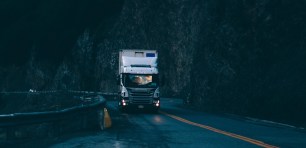
The tuk tuks are named Tük-se and Tack-se, with ‘tack’ meaning ‘thanks’ in Swedish. Source: IKEA
IKEA customers in Sydney will receive packages from two electrified tuk tuks for the next three months, as part of the Swedish homeware giant’s efforts to slash the amount of greenhouse gas emissions from its fleet of petrol-powered delivery trucks.
IKEA has partnered with ANC Delivers to get the tuk tuks on the road, which will be powered by a 9kWh swappable battery, and travel within 10km of the Tempe store from Bondi in the east to Ashfield in the inner west and Mortdale in the southwest.
Customers can receive packages that weigh up to 40 kilograms via the environmentally-friendly three-wheeled vehicles, which include the flat-pack titan’s chairs and coffee table ranges, IKEA said in a statement.
It added that the two vehicles were fittingly named Tük-se and Tack-se, with the word ‘tack’ meaning ‘thanks’ in Swedish.
Manager for IKEA Tempe Tiffany Mosura-Lesnock said her staff were excited to “trial and test innovative methods that help get us closer to our goal of 100% zero emission deliveries”.
“We know that the congested roads of metro Sydney will benefit enormously from the introduction of electric tuk tuks in our delivery fleet, and we also hope it will inspire and drive positive change for the whole industry to meet the needs of people today without compromising the planet and needs of future generations.”
It’s not the first time the multinational has explored alternatives to trucks in a bid to explore zero-emission delivery. There have been electric rickshaws in India, cargo bikes in Madrid, solar bikes in London, and barges down the Seine in Paris.
In its 2022 Sustainability and Climate report, IKEA said its total global climate footprint was 25.8 million tonnes of CO2 eq — a decrease in absolute terms of 5% compared to the financial year prior.
“The continued reduction is mainly due to an increased share of renewable energy in both retail and production, and a more energy-efficient range, particularly through the SOLHETTA LED bulbs,” it notes.
It follows a report that found replacing ten delivery trucks with electric models would have the same positive impact on driving down traffic emissions as putting 56 electric vehicles on the road.
Large trucks account for 15% of transport emissions even though they made up 1% of the vehicle fleet, logistics firm Adiona Tech found, as they travelled six times as far as passenger cars, used 40 times more fuel, and produced 50 times more pollution.
Chief executive Richard Savoie said electrifying the largest vehicles on Australian roads should be considered a “low-hanging fruit” in the fight to net zero.
“Australia is already behind every other developed nation on electric vehicles and while we’re playing catch-up we can’t forget the biggest emitters on the road: freight and transport vehicles,” he said.
“Australia must prioritise the electrification of these vehicles that are on the road most, travel the longest distances and are the least fuel-efficient.”
Handpicked for you

Electric trucks could haul Australia towards its zero-emission targets faster than traditional EVs, study reveals



COMMENTS
SmartCompany is committed to hosting lively discussions. Help us keep the conversation useful, interesting and welcoming. We aim to publish comments quickly in the interest of promoting robust conversation, but we’re a small team and we deploy filters to protect against legal risk. Occasionally your comment may be held up while it is being reviewed, but we’re working as fast as we can to keep the conversation rolling.
The SmartCompany comment section is members-only content. Please subscribe to leave a comment.
The SmartCompany comment section is members-only content. Please login to leave a comment.